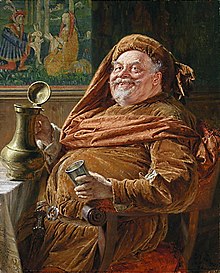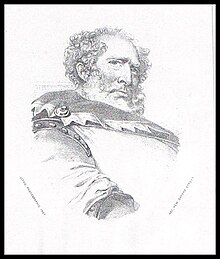John Falstaff
A fat, vain, and boastful knight, he spends most of his time drinking at the Boar's Head Inn with petty criminals, living on stolen or borrowed money.Falstaff has appeared in other works, including operas by Giuseppe Verdi, Ralph Vaughan Williams, and Otto Nicolai, a "symphonic study" by Edward Elgar, and in Orson Welles's 1966 film Chimes at Midnight.The most notable examples in cinema are Laurence Olivier's 1944 version and Kenneth Branagh's 1989 film, both of which draw additional material from the Henry IV plays.According to Leonard Digges, writing shortly after Shakespeare's death, while many plays could not get good audiences, "let but Falstaff come, Hal, Poins, the rest, you scarce shall have a room".He and Poins pretend to go along with a plan by Falstaff and three friends to carry out a highway robbery, but then attack the robbers in disguise and in turn steal their loot, after which Hal returns it to its owner.Hal tells the audience that he will soon abandon this life and assume his rightful high place in affairs by showing himself worthy through some (unspecified) noble exploits.The tone of much of the play is elegiac, focusing on Falstaff's age and his closeness to death, which parallels that of the increasingly sick king.Shallow brings forward potential recruits for the loyalist army: Mouldy, Bullcalf, Feeble, Shadow and Wart, a motley collection of rustic yokels.Although Falstaff does not appear on stage in Henry V, his death is the main subject of Act 2, Scene 3, in which Mistress Quickly delivers a memorable eulogy: Nay, sure, he's not in hell!Falstaff decides to send the women identical love letters and asks his servants – Pistol and Nym – to deliver them to the wives.The "merry wives" are not interested in the ageing, overweight Falstaff as a suitor; however, for the sake of their own amusement and to gain revenge for his indecent assumptions towards them both, they pretend to respond to his advances.When the jealous Ford returns to try and catch his wife with the knight, the wives have the basket taken away and the contents (including Falstaff) dumped into the river.Eventually the wives tell their husbands about the series of jokes they have played on Falstaff, and together they devise one last trick which ends up with the Knight being humiliated in front of the whole town.Eventually they all leave together and Mistress Page even invites Falstaff to come with them: "let us every one go home, and laugh this sport o'er by a country fire; Sir John and all".Cobham was a common butt of veiled satire in Elizabethan popular literature; he figures in Ben Jonson's Every Man in His Humour and may have been part of the reason The Isle of Dogs was suppressed.Shakespeare's desire to burlesque a hero of early English Protestantism could indicate Roman Catholic sympathies, but Henry Brooke, 11th Baron Cobham was sufficiently sympathetic to Catholicism that in 1603, he was imprisoned as part of the Main Plot to place Arbella Stuart on the English throne, so if Shakespeare wished to use Oldcastle to embarrass the Cobhams, he seems unlikely to have done so on religious grounds.Shakespeare may have included a sly retaliation against the complaint in his play The Merry Wives of Windsor (published after the Henry IV series).At any rate, the name is Falstaff in the Henry IV, Part 1 quarto, of 1598, and the epilogue to the second part, published in 1600, contains this clarification: One word more, I beseech you: if you be not too much cloyed with fat meat, our humble author will continue the story, with Sir John in it, and make you merry with fair Katherine of France, where, for anything I know, Falstaff shall die of a sweat, unless already he be killed with your hard opinions; for Oldcastle died a martyr, and this is not the man.He was among the few English military leaders to avoid death or capture during the battle, and although there is no evidence that he acted with cowardice, he was temporarily stripped of his knighthood.







Falstaff (disambiguation)HenriadAdolf SchrödterWilliam ShakespeareHenry IV, Part 1Part 2Prince HalHenry V of EnglandThe Merry Wives of WindsorBoar's Head InnGiuseppe VerdiRalph Vaughan WilliamsOtto NicolaiEdward ElgarOrson WellesChimes at MidnightPacific Repertory TheatreHenry IV, Part 2Henry VKing Henry VLaurence Olivier1944 versionKenneth Branagh1989 filmLeonard DiggesJohann Heinrich RambergPrince of WalescharismaHotspurEduard von GrütznerRobert SmirkeDoll TearsheetAncient PistolMistress QuicklySocratesPhaedohemlockHerne, the HunterWindsor Great ParkfairiesJohn OldcastleLord CobhamThe Famous Victories of Henry VHerefordshireLollardmartyrRaphael HolinshedBen JonsonEvery Man in His HumourThe Isle of DogsRoman CatholicHenry Brooke, 11th Baron CobhamMain PlotArbella StuartMaster of the RevelsEdmund TilneyWilliam Brooke, 10th Baron CobhamLord ChamberlainRobert CecilquartoJohn FastolfBattle of PatayJoan of ArcHenry VI, Part 1First FolioRobert GreeneStephen GreenblattGreene's Groats-Worth of WitRonald GowerFalstaff's WeddingWilliam KenrickScroop's plotGeorge RadfordScandinavianNorfolkStephen KembleFalstaffAntonio SalieriMichael William BalfeDie lustigen Weiber von WindsorLe songe d'une nuit d'étéAmbroise ThomaslibrettoArrigo Boitosymphonic poemAt the Boar's HeadGustav HolstSir John in LoveGordon GettyBill CainversionGeorge RobeyRichard IIVincent CanbyAn Age of KingsRichard IIIFrank PettingellBBC ShakespeareAnthony QuayleRichard Griffiths1989 versionRobbie ColtraneMichael BogdanovMichael PenningtonEnglish Shakespeare CompanyBarry StantonGus Van SantMy Own Private IdahoWilliam RichertThe Hollow CrownSimon Russell BealePhyllida LloydDonmar WarehouseSophie StantonThe KingJoel Edgertonmilitary tacticsBattle of AgincourtUpstart CrowDavid MitchellJames WhiteRobert Barnabas BroughRobert NyeVolstagg the VoluminousMarvel Comicsalter ego